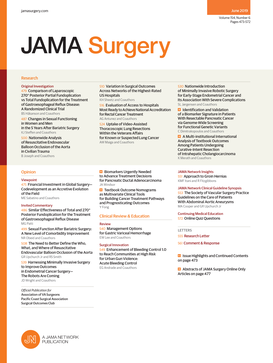Rizedisben in Minimally Invasive Surgery: A Nonrandomized Clinical Trial.
IF 14.9
1区 医学
Q1 SURGERY
引用次数: 0
Abstract
Importance Fluorescence-guided surgery aims to improve intraoperative identification of vital structures. Rizedisben is a myelin-binding fluorophore that fluoresces in the blue light (370-425 nm) spectrum to improve intraoperative nerve identification. Objective To determine the optimal safe and clinically effective dose of rizedisben for sustained intraoperative fluorescence of nerve structures. Design, Setting, and Participants A single-arm, open-label, phase 1 study was conducted in patients undergoing robot-assisted laparoscopic radical prostatectomy (RALP) at an urban academic cancer center in New York City between January 2023 and October 2024. Using a dose escalation design, increasing doses of rizedisben were administered after safety was assessed at each level until a clinically effective dose was determined. The obturator nerve served as the reference nerve for measuring fluorescence intensity. Eligible patients were 18 years old and older, diagnosed with prostate cancer, and scheduled for RALP. Patients were recruited in preoperative clinic visits once deemed eligible for the study. Those with prior pelvic surgery or radiation, known central or peripheral nervous system disease, current use of neurotoxic medications, recent exposure to phototoxic drugs, or serious kidney or liver dysfunction were excluded. Interventions Rizedisben was intravenously administered intraoperatively 30 minutes prior to visualization of the obturator nerve. Main Outcomes and Measures Safety was assessed through 45 postoperative days. Fluorescence was measured via subjective intraoperative scoring and by post hoc objective image analysis. Clinically effective dose was defined as achieving sustained fluorescence of the obturator nerve in 3 or more of 5 patients in 2 consecutive cohorts, provided fewer than 20% of patients experienced grade 2 or greater toxicity. Sustained fluorescence was defined as moderate or better fluorescence for 90 minutes or longer. At the clinically effective dose, fluorescence assessments of the neurovascular bundles were included. Results Thirty-eight patients (median [IQR] age, 61.5 [57.8-66.3] years) enrolled in and completed the trial. Dosing was escalated from 0.25 to 3.0 mg/kg. There was 1 grade 2 adverse event (rash) possibly attributable to rizedisben. Sustained fluorescence of the obturator nerve was achieved in all patients at 3.0 mg/kg. Prostate neurovascular bundles demonstrated evidence of fluorescence in 8 of 9 (89%) patients at 3.0 mg/kg. Conclusions and Relevance In this phase 1 trial of rizedisben, the 3.0-mg/kg dose was shown to be generally well tolerated and clinically effective. At this dose, there was excellent sustained fluorescence of the obturator nerves, and the neurovascular bundles were visualized in 8 of 9 patients. Based on these data, we are designing phase 2 studies with rizedisben for additional indications. Trial Registration ClinicalTrials.gov Identifier: NCT04983862.微创手术中的Rizedisben:一项非随机临床试验。
重要性荧光引导手术旨在提高术中重要结构的识别。Rizedisben是一种髓磷脂结合荧光团,在蓝光(370-425 nm)光谱下发出荧光,以改善术中神经识别。目的确定利泽地本术中神经结构持续荧光的最佳安全和临床有效剂量。设计、环境和参与者:一项单臂、开放标签、一期研究于2023年1月至2024年10月在纽约市的一个城市学术癌症中心进行了机器人辅助腹腔镜根治性前列腺切除术(RALP)的患者。采用剂量递增设计,在每个级别评估安全性后增加给药剂量,直到确定临床有效剂量。以闭孔神经作为荧光强度测量的参考神经。符合条件的患者为18岁及以上,诊断为前列腺癌,并计划进行RALP。一旦被认为符合研究条件,患者在术前就诊时被招募。既往有盆腔手术或放疗,已知中枢或周围神经系统疾病,目前使用神经毒性药物,最近暴露于光毒性药物,或严重的肾脏或肝脏功能障碍的患者被排除在外。干预措施术中观察闭孔神经前30分钟静脉给予rizedisben。主要结局和措施术后45天进行安全性评估。通过主观术中评分和事后客观图像分析测量荧光。临床有效剂量定义为在连续2个队列的5名患者中有3名或更多患者实现闭孔神经持续荧光,前提是少于20%的患者出现2级或以上毒性。持续荧光定义为中等或较好的荧光持续90分钟或更长时间。在临床有效剂量下,包括神经血管束的荧光评估。结果38例患者(中位[IQR]年龄为61.5[57.8-66.3]岁)入组并完成试验。剂量从0.25 mg/kg增加到3.0 mg/kg。有1例2级不良事件(皮疹)可能归因于利泽地本。所有患者在3.0 mg/kg剂量下均实现了闭孔神经的持续荧光。在3.0 mg/kg剂量下,9例患者中有8例(89%)的前列腺神经血管束显示荧光。结论和相关性在这项瑞泽地本的1期临床试验中,3.0 mg/kg的剂量被证明具有良好的耐受性和临床效果。在此剂量下,闭孔神经有良好的持续荧光,9例患者中有8例可见神经血管束。基于这些数据,我们正在设计rizedisben用于其他适应症的2期研究。临床试验注册号:NCT04983862。
本文章由计算机程序翻译,如有差异,请以英文原文为准。
求助全文
约1分钟内获得全文
求助全文
来源期刊

JAMA surgery
SURGERY-
CiteScore
20.80
自引率
3.60%
发文量
400
期刊介绍:
JAMA Surgery, an international peer-reviewed journal established in 1920, is the official publication of the Association of VA Surgeons, the Pacific Coast Surgical Association, and the Surgical Outcomes Club.It is a proud member of the JAMA Network, a consortium of peer-reviewed general medical and specialty publications.
 求助内容:
求助内容: 应助结果提醒方式:
应助结果提醒方式:


